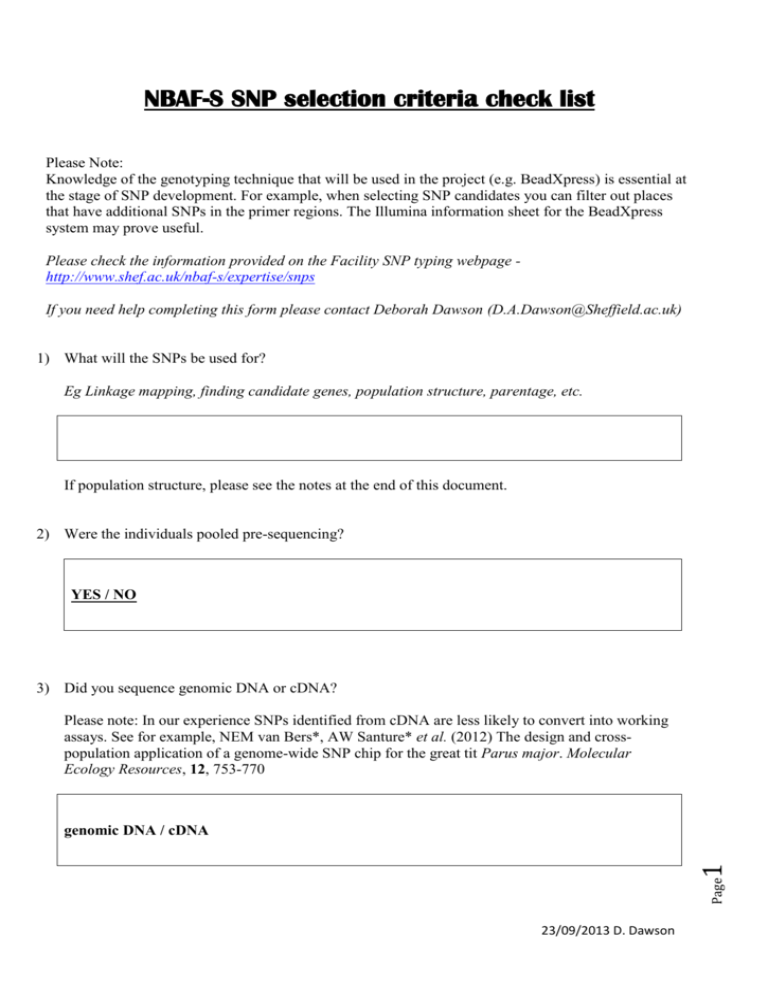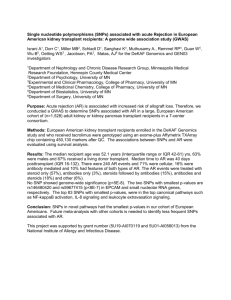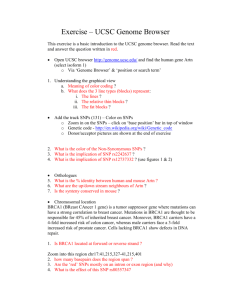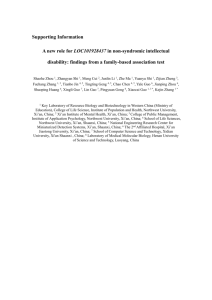SNP typing checklist
advertisement

NBAF-S SNP selection criteria check list Please Note: Knowledge of the genotyping technique that will be used in the project (e.g. BeadXpress) is essential at the stage of SNP development. For example, when selecting SNP candidates you can filter out places that have additional SNPs in the primer regions. The Illumina information sheet for the BeadXpress system may prove useful. Please check the information provided on the Facility SNP typing webpage http://www.shef.ac.uk/nbaf-s/expertise/snps If you need help completing this form please contact Deborah Dawson (D.A.Dawson@Sheffield.ac.uk) 1) What will the SNPs be used for? Eg Linkage mapping, finding candidate genes, population structure, parentage, etc. If population structure, please see the notes at the end of this document. 2) Were the individuals pooled pre-sequencing? YES / NO 3) Did you sequence genomic DNA or cDNA? Please note: In our experience SNPs identified from cDNA are less likely to convert into working assays. See for example, NEM van Bers*, AW Santure* et al. (2012) The design and crosspopulation application of a genome-wide SNP chip for the great tit Parus major. Molecular Ecology Resources, 12, 753-770 Page 1 genomic DNA / cDNA 23/09/2013 D. Dawson 4) A. How many individuals were sequenced? xx Please provide sample details: Sample id Species Population origin Sex B. How many individuals were sequenced per population? _xx_ / population C. Which of the populations used are expected to be more genetically distant than other populations in the study? 5) What criteria was used to select the SNPs ? (to ensure the quality of your SNPs and avoid picking up sequencing errors or singletons) Eg SNP’s were identified, and those that were polymorphic within the pooled sample (of xxx populations) were selected for further analysis. If no, please provide more details Mean= xx, Min=xx, Max=xx Mean= xx, Min=xx, Max=xx Mean= xx, Min=xx, Max=xx 2 Read length? Read depth? Number of reads for minor allele? Depth and genotype quality ?* How were (microsatellite) repeats avoided in alignments? YES / NO Page Did you select/use only biallelic SNPs? 23/09/2013 D. Dawson *Depth is the number of good quality bases overlapping a position. Good quality bases are defined as bases with a Phred quality greater than 20. Genotype quality is produced by the SNP caller and relates to the probability of a genotype being wrong. It is also a Phred quality. If a suitable genome is available please also complete Section B. 6) What equipment and method was used to obtain the sequence data (and why)? Eg Sequenced with an Illumina HiSeq using 150bp pair-end reads. 7) What is the mean length of the sequences obtained and the minimum and maximum size? 8) Where was the sequencing done? Eg Sequencing was done at NBAF-Edinburgh. 9) How much data were obtained? Eg We obtained about 6900Mb of data A. How many candidate SNPs have been provided? 3 B. How many SNPs do you need (as in the application form, 48, 96, 144, 192 or 384 SNPs)? Page 10) 23/09/2013 D. Dawson 11) A. Did you run the SNP sequences through the Illumina software (Assay Design Tool) to check for any potential problems during primer design? YES / NO B. After (quality control) avoiding problems highlighted by the Illumina software, are there still enough to choose from in order to get the final number of (xxx) SNPs required (state how many)? YES / NO xxx SNPs required 12) Have any of the SNPs been validated by genotyping (please provide details)? YES / NO 4 Please provide any other information which may be useful regarding selecting the SNPs: Page 13) 23/09/2013 D. Dawson Section B Please complete the section below only if a suitable sequenced genome is available. 14) Were the sequencing reads aligned against a genome? YES / NO If aligned against a genome, please answer questions below. 15) What was the genome coverage of the sequence data obtained? Eg We obtained about 6900Mb of data (~18x genome coverage). 16) Were repetitive regions masked during sequence comparison when aligning to the genome? YES / NO (If yes, please name software used) 17) How many linkage groups were the SNPs selected from? Eg We selected 900 candidates throughout the genome, covering all 20 major linkage groups (chromosomes) in proportion to the overall size of each chromosome. 18) How are the SNPs separated and spread across the genome (basepair distances)? Page 5 Eg Any particular SNP within a linkage group was separated from the nearest SNP in the panel by several thousand bp or more. 23/09/2013 D. Dawson Notes IMPORTANT CONSIDERATIONS FOR POPULATION STUDIES: It is important to avoid causing ascertainment bias in the population structure analysis due to the way the SNPs are selected. i.e. SNP should not be selected using the criteria of variability between the populations compared nor the allele frequencies in the populations compared. For example, to avoid this problem of bias (with microsatellite data), one could genotype 4-6 individuals – with each individual from a separate population and we then retain the loci that are heterozygous in any individual (even if not heterozygous in the population from which the sequence (used to design the primer set) was isolated. Only if all individuals are all homozygotes and if all the same allele size, would one avoid using the locus as part of the genotyping set. SNP typing: Variability During the process to select SNPs, when different individuals have been sequenced separately and belong to different populations, the SNPs selected for use should include those SNPs variable in any number of populations, including those SNPs variable in only one population. Eg If three individuals were sequenced from each of two populations – SNPs should be retained that were 1) variable in only one (either one) of the two populations and 2) also retained that were variable in both populations. If only the SNPs were retained which were variable in both populations it would bias the data and falsify the results to make it look as if those two populations were more similar than other populations in the study. If only the SNPs that were different in one population were kept, this would falsify the results and make it appear that the two populations were less genetically similar than they truly are. Page 6 Allele frequencies Care should also be taken to avoid bias in population structure studies based on selecting SNPs based on the allele frequencies observed in different populations. If several individuals from the same population were sequenced for more than one population, the allele frequencies observed may be inaccurate (if based on few individuals) but regardless of this the population-specific allele frequencies of the SNPs should not be used in the choice of the SNPs to be retained and used for a study of population structure or they will bias the data in similar ways to those described above. 23/09/2013 D. Dawson






